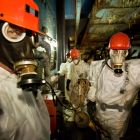Gerd Ludwig
The Long Shadow of Chernobyl
National Geographic photographer Gerd Ludwig has visited Chernobyl over 10 times in the past 25 years, venturing farther into the reactor than any other photographer to document the world’s worst nuclear disaster to date.
At 1:23 am on 26 April 1986, reactor #4 blew up at the Chernobyl Nuclear Power Plant after operators botched a safety test, triggering an explosion and fire that burned for 10 days. The radioactive fallout spread thousands of kilometers, driving over 250,000 people permanently from their homes. To this day, the long shadow of Chernobyl continues to darken lives – socially, environmentally and physically.
“After donning protective gear – a Geiger counter, dosimeter and thick plastic coveralls – I followed workers into the belly of the beast. The workers, assigned to drill holes in the concrete, additionally wore gas masks and oxygen tanks. We had to move fast; radiation here was so high that access was limited to a 15 minutes a day.
In the 1970s, the town of Pripyat, only three kilometres from the reactor, was constructed for the plant’s personnel. Once a beautiful Soviet town, its 50,000 residents were evacuated 36 hours after the accident. Today it is a chilling ghost town, bearing witness to the hasty departure. Amidst the decay, nature reclaims Pripyat – trees grow through windows and grass pushes through cracks. Yet, the area remains unfit for human habitation for hundreds of years to come. Ignoring radiation levels, hundreds of elderly people returned to their homes inside the Exclusion Zone, preferring to die on their own contaminated soil instead of a broken heart in anonymous city suburbs.
Scientists and medical personnel see a clear connection between increasing health issues and radioactivity released by the disaster. Scientist Alexei Okeanov described the health effects of the accident as “a fire that can’t be put out in our lifetimes.”
“As photographers, we often report on human tragedy in the face of disaster with the understanding that our explorations come with personal risk. We do this out of a deep commitment to important stories told on behalf of otherwise voiceless victims like these in Chernobyl, who allowed me to expose their suffering in the hope that such tragedies may be prevented in the future.”
With the support of Edition Lammerhuber, Baden.
INFO POINT
Tourist Information Baden
Brusattiplatz 3, 2500 Baden bei Wien
Open during the photo festival:
Monday – Friday: 10.00 – 16.00 hrs
Saturday: 13.00 – 17.00 hrs (June – August)
Saturday: 13.30 – 17.00 hrs (September – October)
Closed on Sundays and public holidays!
Tel: +43 (0) 2252 86800 600
info@baden.at
Festivalbüro La Gacilly-Baden Photo
Tel: +43 (0) 2252 42269
festival@lagacilly-baden.photo



